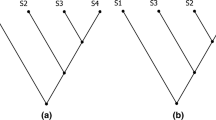Abstract
Acceptable methods of defining taxon (or clade) names in the draft PhyloCode, or so-called phylogenetic nomenclature, are “node based,” “stem based,” and “apomorphy based.” All of them define a clade name by pinpointing a node; whereas node-based and stem-based definitions require two or more taxon “specifiers” to define names, an apomorphy-based definition requires two specifiers of different types; namely, a single-taxon specifier and a character specifier. The taxon specifier in an apomorphy-based definition is completely different from the “type” in the Linnaean system. Taxon (or clade) names in the PhyloCode are characterized in two entirely different manners: One is a name that does not change, either in its orthography or in the contents of the taxon referred to by it (or its meaning) over time; the other is a name that is just like a pure mark and thus has no meaning. Communication through such PhyloCode names is very ineffective or impossible.
Similar content being viewed by others
Literature Cited
Bryant, H. N. &P. D. Cantino. 2002. A review of criticisms of phylogenetic nomenclature: Is taxonomic freedom the fundamental issue? Biol. Rev. Cambridge Philos. Soc. 77: 39–55.
Cantino, P. D. & K. de Queiroz. 2000. PhyloCode: A phylogenetic code of biological nomenclature. <http://www.ohiou.edu/phylocode/>.
Carpenter, J. M. 2003. Critique of pure folly. Bot. Rev. (Lancaster) 69: 79–92.
De Queiroz, K. 1996. A phylogenetic approach to biological nomenclature as an alternative to the Linnaean systems in current use.In J. L. Reveal (ed.), Proceedings of a Mini-Symposium on Biological Nomenclature in the 21st Century, held at the University of Maryland on 4 November 1996. <http://www.inform.umd.edu/PBIO/nomcl/dequ.html>.
—. 1997. The Linnaean hierarchy and the evolutionization of taxonomy, with emphasis on the problem of nomenclature. Aliso 15: 125–144.
—. 2000. The definitions of taxon names: A reply to Stuessy. Taxon 49: 533–536.
— &J. Gauthier. 1990. Phylogeny as a central principle in taxonomy: Phylogenetic definitions of taxon names. Syst. Zool. 39: 307–322.
Lee, M. S. Y. 2001. On recent arguments for phylogenetic nomenclature. Taxon 50: 175–180.
Nixon, K. C. &J. M. Carpenter. 2000. On the other “Phylogenetic Systematics.” Cladistics 16: 298–318.
Schuh, R. T. 2003. The Linnaean system and its 250 year persistence. Bot. Rev. (Lancaster) 69: 59–78.
Stuessy, T. F. 2000. Taxon names arenot defined. Taxon 49: 231–233.
—. 2001. Taxon names arestill not defined. Taxon 50: 185–186.
Author information
Authors and Affiliations
Rights and permissions
About this article
Cite this article
Kojima, JI. Apomorphy-based definition also pinpoints a node, and PhyloCode names prevent effective communication. Bot. Rev 69, 44–58 (2003). https://doi.org/10.1663/0006-8101(2003)069[0044:ADAPAN]2.0.CO;2
Issue Date:
DOI: https://doi.org/10.1663/0006-8101(2003)069[0044:ADAPAN]2.0.CO;2




